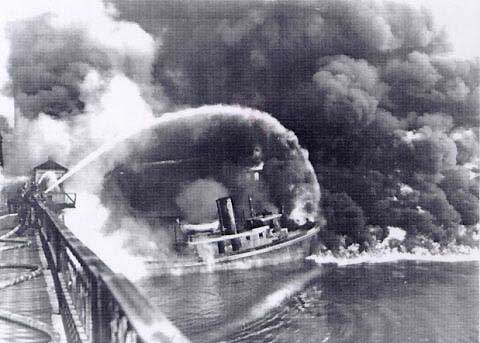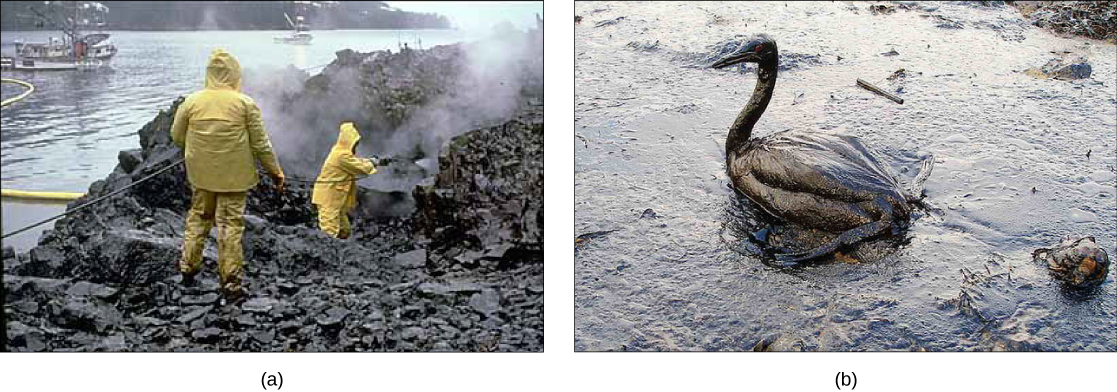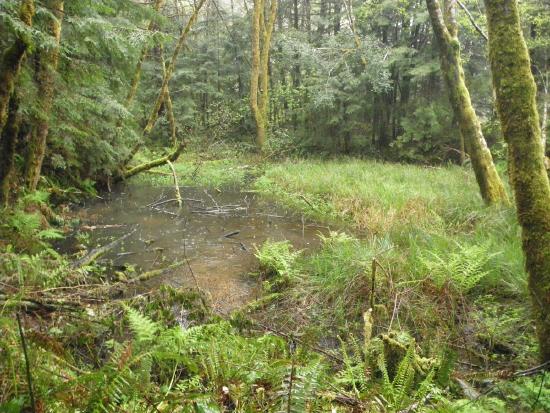12.5: Mitigating Water Pollution
- Page ID
- 69476
Water pollution can be mitigated through regulation, bioremediation, and watershed management.
Regulation
During the early 1900s, rapid industrialization in the U.S. resulted in widespread water pollution due to free discharge of waste into surface waters. The Cuyahoga River in northeast Ohio caught fire numerous times, including a famous fire in 1969 that caught the nation’s attention (figure \(\PageIndex{1}\)). In 1972 Congress passed one of the most important environmental laws in U.S. history, the Federal Water Pollution Control Act, which is more commonly called the Clean Water Act (CWA). The purpose of the Clean Water Act and later amendments is to maintain and restore water quality, or in simpler terms to make our water swimmable and fishable. It became illegal to dump pollution into surface water unless there was formal permission. The CWA regulates pollution from a single source such as that from industry or sewage treatment plants by setting pollution standards (maximum levels of each pollutant that can be in bodies of water or released at a time). United States water quality improved significantly as a result, but as there is still more work to be done. More progress is needed because currently the EPA considers over 40,000 U.S. water bodies as impaired, most commonly due to pathogens, metals, plant nutrients, and oxygen depletion. Another concern is protecting groundwater quality, which is not yet addressed sufficiently by federal law.

Figure \(\PageIndex{1}\): Cuyahoga River on fire in 1969. Image from USEPA Environmental-Protection-Agency (public domain).
Nonpoint sources of water pollution, e.g., agricultural runoff and urban runoff (Figure \(\PageIndex{2}\)), are much harder to regulate because of their widespread, diffuse nature. There are many construction and agricultural practices that reduce polluted runoff including no-till farming and sediment traps. Artificial aeration or mechanical mixing can remediate lakes with oxygen depletion. Specific things that we can do to reduce urban runoff include the following: keep soil, leaves, and grass clippings off driveways, sidewalks, and streets; don't pour used motor oil, antifreeze, paints, pesticides, or any household hazardous chemical down the storm sewer or drain; recycle used motor oil; use hazardous waste disposal programs offered by the community; compost your organic waste; don't use fertilizers and herbicides on your lawn; and flush pet waste down the toilet.

Figure \(\PageIndex{2}\): Storm Drain Curbside storm drain receiving urban runoff. Source: By Robert Lawton via Wikimedia Commons
In the past, domestic and commercial refuse was commonly trucked to a “dump” (typically a hole in the ground), and when the hole was filled, it was covered with soil and forgotten. In situations like this, rain and melting snow can easily pass through the soil used to cover the refuse. This water passes into the waste itself, and the resulting landfill leachate that flows from the bottom of the landfill can seriously contaminate the surrounding groundwater and surface water. In the past few decades, regulations around refuse disposal have been significantly strengthened, and important steps have been taken to reduce the amount of landfill waste by diverting recyclable and compostable materials to other locations.
There are two fairly simple ways to significantly reduce the chance and degree of groundwater contamination from surface sources. One is to prevent rainwater from infiltrating down to the water table and picking up contaminants; this can be achieved by simply capping or roofing over the landfill, mine tailings, or spill site. The second is to provide an impermeable barrier beneath the contaminant. Modern landfills and mine tailings impoundments are all built using some combination of clay and engineered plastic barriers. Both of these solutions — caps and liners — are subject to failure due to leaks.
A modern engineered landfill has an impermeable liner (typically heavy plastic, although engineered clay liners or natural clay may be adequate in some cases), a plumbing system for draining leachate (the rainwater that flows through the refuse and becomes contaminated), and a network of monitoring wells both within and around the landfill (Figure \(\PageIndex{3}\)). Once part or all of a landfill site is full, it is sealed over with a plastic cover. The leachate must be treated, and that can be done in a normal sewage treatment plant. The monitoring wells are used to assess the level of the water table around the landfill and to collect groundwater samples so that any leakage can be detected. Because some leakage is almost inevitable, the ideal placement for landfills is in areas where the depth to the water table is significant (tens of meters if possible) and where the aquifer material is relatively impermeable. Landfills should also be situated far from streams, lakes, or wetlands so that contamination of aquatic habitats can be avoided.
Remediation
Remediation is the act of cleaning contamination. Biological remediation (bioremediation) is a waste management technique that involves the use of organisms such as plants, bacteria, and fungi to remove or neutralize pollutants from a contaminated site. According to the United States EPA, bioremediation is a “treatment that uses naturally occurring organisms to break down hazardous substances into less toxic or nontoxic substances”. This type of remediation is usually used on organic chemicals but also works on reducing or oxidizing inorganic chemicals like nitrate. Phytoremediation is a type of bioremediation that uses plants to absorb the chemicals over time.
Bioremediation is widely used to treat human sewage and has also been used to remove agricultural chemicals (pesticides and fertilizers) that leach from soil into groundwater. Certain toxic metals, such as selenium and arsenic compounds, can also be removed from water by bioremediation. Mercury is an example of a toxic metal that can be removed from an environment by bioremediation. Several species of bacteria can carry out the biotransformation of toxic mercury into nontoxic forms. These bacteria, such as Pseudomonas aeruginosa, can convert a charged form of mercury (Hg2+) to an uncharged form (Hg), which is less toxic to humans.
Probably one of the most useful and interesting examples of the use of prokaryotes for bioremediation purposes is the cleanup of oil spills. To clean up these spills, bioremediation is promoted by adding inorganic nutrients that help bacteria already present in the environment to grow. Hydrocarbon-degrading bacteria feed on the hydrocarbons in the oil droplet, breaking them into inorganic compounds. Some species, such as Alcanivorax borkumensis, produce surfactants that break the oil into droplets, making it more accessible to the bacteria that degrade the oil. In the case of oil spills in the ocean, ongoing, natural bioremediation tends to occur, inasmuch as there are oil-consuming bacteria in the ocean prior to the spill. Under ideal conditions, it has been reported that up to 80 percent of the nonvolatile components (those that do not readily evaporate) in oil can be degraded within one year of the spill. Researchers have genetically engineered other bacteria to consume petroleum products; indeed, the first patent application for a bioremediation application in the U.S. was for a genetically modified oil-eating bacterium.

Figure \(\PageIndex{4}\): (a) Cleaning up oil after the Exxon Valdez spill in Alaska (1989), the workers hosed oil from beaches and then used a floating boom to corral the oil, which was finally skimmed from the water surface. Some species of bacteria are able to solubilize and degrade the oil. (b) One of the most catastrophic consequences of oil spills is the damage to fauna. (credit a: modification of work by NOAA; credit b: modification of work by GOLUBENKOV, NGO: Saving Taman)
There are a number of cost/efficiency advantages to bioremediation, which can be employed in areas that are inaccessible without excavation. For example, hydrocarbon spills (specifically, oil spills) or certain chlorinated solvents may contaminate groundwater, which can be easier to treat using bioremediation than more conventional approaches. This is typically much less expensive than excavation followed by disposal elsewhere, incineration, or other off-site treatment strategies. It also reduces or eliminates the need for “pump and treat”, a practice common at sites where hydrocarbons have contaminated clean groundwater. Using microorganisms for bioremediation of hydrocarbons also has the advantage of breaking down contaminants at the molecular level, as opposed to simply chemically dispersing the contaminant.
Chemical remediation uses the introduction of chemicals to remove the contaminant or make it less harmful. One example is reactive barriers, a permeable wall in the ground or at a discharge point that chemically reacts with contaminants in the water. Reactive barriers made of limestone can increase the pH of acid mine drainage, making the water less acidic and more basic, which removes dissolved contaminants by precipitation into a solid form. Physical remediation consists of removing the contaminated water and either treating it (aka pump and treat) with filtration or disposing of it. All of these options are technically complex, expensive, and difficult, with physical remediation typically being the most costly.
Specific treatment methods for groundwater contamination depend on the geology, hydrology, and pollutant because some light contaminants flow on top of groundwater, others dissolve and flow with groundwater, and dense contaminants can sink below groundwater. Sometimes slow flow through a soil can naturally purify groundwater because some pollutants, such as P, pesticides, and heavy metals, chemically bind with surfaces of soil clays and iron oxides. Other pollutants are not retained by soil particles: These include N, road salt, gasoline fuel, the herbicide atrazine, tetrachloroethylene (a carcinogenic cleaning solvent used in dry cleaning), and vinyl chloride. In other cases, slow groundwater flow can allow bacteria to decompose dead organic matter and certain pesticides. A common cleanup method called pump and treat involves pumping out the contaminated groundwater and treating it by oxidation, filtration, or biological methods. Sometimes soil must be excavated and sent to a landfill. In-situ treatment methods include adding chemicals to immobilize heavy metals, creating a permeable reaction zone with metallic iron that can destroy organic solvents, or using bioremediation by adding oxygen or nutrients to stimulate growth of microorganisms.
Watershed Management
Watershed management involves reducing chemicals applied to land in the watershed (which will drain into a body of water) and runoff of those chemicals (figure \(\PageIndex{5-6}\)). This strategy is more effective for nonpoint source pollution than setting pollution standards (as the CWA does) because it does not require each source of pollution be identified.

Figure \(\PageIndex{5}\): While some watersheds are relatively small, others encompass thousands of square miles and may contain streams, rivers, lakes, reservoirs, and underlying groundwater that are hundreds of miles inland. Shown here is an aerial view of Drakes Bay, part of California's Tomales-Drake watershed. Image and caption (modified) from Brian Cluer, NOAA Fisheries West Coast Region, California Coastal Office (public domain).

Figure \(\PageIndex{6}\): Diagram of a watershed, the area that drains into a body of water. The drainage-basin boundary defines the edges of the watershed. Precipitation falls on the watershed. Some reenters the atmosphere through evaporation or evapotranspiration. The water collects into smaller streams, which drain into a larger river. Additionally, surface water can enter the watershed (surface-water inflow) as water imported through pipelines or canals. Surface water exits the watershed (surface-water outflow) as water exported through pipelines canals. Similarly, ground-water inflow enters the system, and ground-water outflow exits the system. Ground water is stored in the aquifer underground, and the water table marks upper level of groundwater in the aquifer. Image from Healy, R.W., Winter, T.C., LaBaugh, J.W., and Franke, O.L., 2007, : Water budgets: Foundations for effective water-resources and environmental management: U.S. Geological Survey Circular 1308.
Maintaining or restoring riparian areas (riparian zones) is key to watershed management (figure \(\PageIndex{7}\)). These are areas of land close enough to a body of water to be affected by that body of water, for example, the lush region of vegetation surrounding a river. Riparian areas provide many ecosystem services that promote water quality and limit pollution. The vegetation absorbs nutrients that could otherwise cause eutrophication. It also provide shade, keeping the water cool and increasing its capacity to hold dissolved oxygen. The roots of the vegetation cling to soil, combating erosion. Additionally, roots and low-lying plants slow the flow of run-off, promoting infiltration. High infiltration rates have several benefits: (1) less runoff is available to bring pollution to the river, lake, or bay, (2) pollutants will be filtered from the runoff as it soaks into the ground, and (3) aquifers are replenished.

Figure \(\PageIndex{7}\): Riparian areas reduce water pollution by absorbing nutrients, keeping water cool, limiting erosion, and promoting infiltration. Image by BLM (public domain).
Watershed management plans typically leave undisturbed riparian vegetation directly adjacent to a body of water (figure \(\PageIndex{8}\)). Next (moving away from the water), could be managed forest followed by agriculture. The most intensive agriculture should be farthest from the body of water, particularly when pesticides and fertilizers are in use.

Figure \(\PageIndex{8}\): Although riparian forest buffers are often designed primarily for water quality benefits, these practices can also include woody species that provide products such as nuts, fruit, and decorative woody florals. These are examples of non-timber forest products. Zone 1, which is closest to the river, is unmanaged forest. Zone 2 contains managed nut or fruit trees and shrubs. Zone 3 contains managed woody florals and forbs. (Forbs are non-woody plants excluding grasses.) Image and caption by USDA National Agroforestry Center (public domain).
In urban areas can also be carefully structured to limit water pollution. Rain gardens next to buildings are areas with soil and vegetation that promote infiltration. Permeable pavement, which allows water to pass through it, also promotes infiltration, and reduces runoff, creating fewer opportunities for the water to acquire pollutants from washing over a dirty street.
Contributors and Attribution
Modified by Kyle Whittinghill and Melissa Ha from the following sources:
- Water Contamination from An Introduction to Geology by Johnson et al. (licensed under CC-BY-NC-SA)
- Water Treatment and Bioremediation from Environmental Biology by Matthew R. Fisher (licensed under CC-BY)
- Water Pollution from Sustainability: A Comprehensive Foundation by Tom Theis and Jonathan Tomkin, Editors. Download for free at CNX. (licensed under CC-BY)
- Essentials of Environmental Science by Kamala Doršner is licensed under CC BY 4.0
- Groundwater Quality from Physical Geology by Steven Earle


